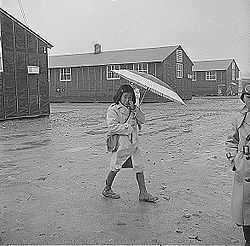Executive Order 9066


United States Executive Order 9066 was a United States presidential executive order signed and issued during World War II by the United States President Franklin D. Roosevelt on February 19, 1942, authorizing the Secretary of War to prescribe certain areas as military zones. Eventually, EO 9066 cleared the way for the deportation of Japanese Americans to internment camps. The executive order was spurred by a combination of war hysteria and reactions to the Niihau Incident.
"Now, therefore, by virtue of the authority vested in me as President of the United States, and Commander in Chief of the Army and Navy, I hereby authorize and direct the Secretary of War, and the Military Commanders whom he may from time to time designate, whenever he or any designated Commander deems such action necessary or desirable, to prescribe military areas in such places and of such extent as he or the appropriate Military Commander may determine, from which any or all persons may be excluded, and with respect to which, the right of any person to enter, remain in, or leave shall be subject to whatever restrictions the Secretary of War or the appropriate Military Commander may impose in his discretion. The Secretary of War is hereby authorized to provide for residents of any such area who are excluded therefrom, such transportation, food, shelter, and other accommodations as may be necessary, in the judgment of the Secretary of War or the said Military Commander, and until other arrangements are made, to accomplish the purpose of this order. The designation of military areas in any region or locality shall supersede designations of prohibited and restricted areas by the Attorney General under the Proclamations of December 7 and 8, 1941, and shall supersede the responsibility and authority of the Attorney General under the said Proclamations in respect of such prohibited and restricted areas."
Americans of Italian and German ancestry were also targeted by these restrictions, including internment. 11,000 people of German ancestry were interned, as were 3,000 people of Italian ancestry, along with some Jewish refugees. The interned Jewish refugees came from Germany, as the U.S. government did not differentiate between ethnic Jews and ethnic Germans (Jewish was defined as a religious practice). Some of the internees of European descent were interned only briefly, while others were held for several years beyond the end of the war. Like the Japanese internees, these smaller groups had American-born citizens in their numbers, especially among the children. A few members of ethnicities of other Axis countries were interned, but exact numbers are unknown.
Secretary of War Henry L. Stimson was responsible for assisting relocated people with transport, food, shelter, and other accommodations.
Post-World War II
Executive Order 9066 was rescinded by Gerald Ford on February 19, 1976.[1] In 1980, Jimmy Carter signed legislation to create the Commission on Wartime Relocation and Internment of Civilians (CWRIC). The CWRIC was appointed to conduct an official governmental study of Executive Order 9066, related wartime orders, and their impact on Japanese Americans in the West and Alaska Natives in the Pribilof Islands.
In December 1982, the CWRIC issued its findings in Personal Justice Denied, concluding that the incarceration of Japanese Americans had not been justified by military necessity. The report determined that the decision to incarcerate was based on "race prejudice, war hysteria, and a failure of political leadership". The Commission recommended legislative remedies consisting of an official Government apology and redress payments of $20,000 to each of the survivors; a public education fund was set up to help ensure that this would not happen again (Public Law 100-383).
On August 10, 1988, the Civil Liberties Act of 1988, based on the CWRIC recommendations, was signed into law by Ronald Reagan. On November 21, 1989, George H. W. Bush signed an appropriation bill authorizing payments to be paid out between 1990 and 1998. In 1990, surviving internees began to receive individual redress payments and a letter of apology. This bill only applied to the Japanese Americans.
The day the Executive Order was signed is now that of the Day of Remembrance, an annual commemoration of the internments in the Japanese American community.[2]
See also
- Executive Order 9102
- War Relocation Authority
- German American internment
- Italian American internment
- Hirabayashi v. United States
- Korematsu v. United States
- Ex parte Endo
- Defence Regulation 18B
- Niihau Incident
References
External links
| Wikimedia Commons has media related to Japanese American internment. |
| Wikisource has original text related to this article: |
- Text of Executive Order No. 9066
- Instructional poster for San Francisco
- Instructional poster for Los Angeles
- German American Internment Coalition
- FOITimes a resource for European American Internment of World War 2
- “The War Relocation Centers of World War II: When Fear Was Stronger than Justice”, a National Park Service Teaching with Historic Places (TwHP) lesson plan
- JapaneseRelocation.org searchable data for over 100,00 Japanese Americans Interned at camps